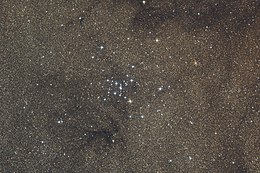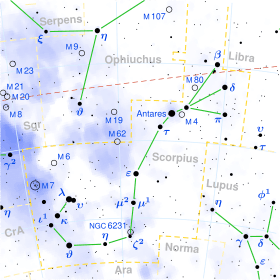V957 Scorpii
V957 Scorpii is a variable star in the constellation of Scorpius. It is a blue straggler in the open cluster Messier 7, a star that is unexpectedly hot compared to other members of the cluster.
| Observation data Epoch J2000 Equinox J2000 | |
|---|---|
| Constellation | Scorpius |
| Right ascension | 17h 52m 13.662s[1] |
| Declination | −34° 47′ 57.11″[1] |
| Apparent magnitude (V) | 5.87[2] |
| Characteristics | |
| Spectral type | B5 IIIp[3] |
| U−B color index | -0.64[4] |
| B−V color index | -0.10[4] |
| Variable type | SX Ari[2] |
| Astrometry | |
| Radial velocity (Rv) | -9.70[5] km/s |
| Proper motion (μ) | RA: 3.148[1] mas/yr Dec.: -5.604[1] mas/yr |
| Parallax (π) | 3.6766 ± 0.1521[1] mas |
| Distance | 890 ± 40 ly (270 ± 10 pc) |
| Absolute magnitude (MV) | -1.441[6] |
| Details | |
| Mass | 5.13[7] M☉ |
| Radius | 4.00[7] R☉ |
| Luminosity | 1,148[7] L☉ |
| Surface gravity (log g) | 3.94[7] cgs |
| Temperature | 16,600[7] K |
| Metallicity [Fe/H] | +0.01[8] dex |
| Rotational velocity (v sin i) | 30[9] km/s |
| Age | 50[7] Myr |
| Other designations | |
| Database references | |
| SIMBAD | data |
Spectrum
V957 Scorpii shows a peculiar B5 or B6 spectrum. Its luminosity class has been given as main sequence (V), subgiant (IV), giant (III), and supergiant (Ib).[10] From its position in the H-R diagram, it is actually thought to be a main sequence star.[11] With a helium abundance 25 times lower than that of the sun,[12] it is classified as helium-weak. It also has a low carbon abundance and a strong magnetic field.[7]
Messier 7

Messier 7 is a naked-eye open cluster. Except for one obvious orange giant star, its brightest members are mostly early A and late B main sequence stars and giants. Several of them are also chemically peculiar stars. However, two stars are hotter than the others and lie to the left of the isochrone for the cluster. These are the blue stragglers HD 162586 and V957 Scorpii. V957 Scorpii is considered 92% likely to be a member of M7. M7 has an age around 220 million years, but the apparent age of V957 Scorpii is less than 100 million years.[12]
Variability
V957 Scorpii varies in brightness by about 0.05 magnitudes. This is thought to be due to its rotation and variations in its surface brightness. It is classified as an SX Arietis variable, also known as helium variables. Their spectral lines also vary as the stars rotate.[2]
References
- Brown, A. G. A.; et al. (Gaia collaboration) (August 2018). "Gaia Data Release 2: Summary of the contents and survey properties". Astronomy & Astrophysics. 616. A1. arXiv:1804.09365. Bibcode:2018A&A...616A...1G. doi:10.1051/0004-6361/201833051. Gaia DR2 record for this source at VizieR.
- Samus, N. N.; Durlevich, O. V.; et al. (2009). "VizieR Online Data Catalog: General Catalogue of Variable Stars (Samus+ 2007-2013)". VizieR On-line Data Catalog: B/GCVS. Originally Published in: 2009yCat....102025S. 1: B/gcvs. Bibcode:2009yCat....102025S.
- . Bibcode:1985ApJ...294L.103A. Cite journal requires
|journal=(help); Missing or empty|title=(help) - Hoffleit, D.; Warren, W. H. (1995). "VizieR Online Data Catalog: Bright Star Catalogue, 5th Revised Ed. (Hoffleit+, 1991)". VizieR On-line Data Catalog: V/50. Originally Published in: 1964BS....C......0H. 5050. Bibcode:1995yCat.5050....0H.
- . Bibcode:1974A&A....34..393C. Cite journal requires
|journal=(help); Missing or empty|title=(help) - . Bibcode:2014A&A...566A.132S. Cite journal requires
|journal=(help); Missing or empty|title=(help) - . Bibcode:2019AstBu..74...66G. Cite journal requires
|journal=(help); Missing or empty|title=(help) - . Bibcode:2012PAZh...38..860G. Cite journal requires
|journal=(help); Missing or empty|title=(help) - . Bibcode:2012A&A...537A.120Z. Cite journal requires
|journal=(help); Missing or empty|title=(help) - . Bibcode:2014yCat....1.2023S. Cite journal requires
|journal=(help); Missing or empty|title=(help) - . Bibcode:1982A&A...109...37M. Cite journal requires
|journal=(help); Missing or empty|title=(help) - . Bibcode:2000A&A...356..517A. Cite journal requires
|journal=(help); Missing or empty|title=(help)
